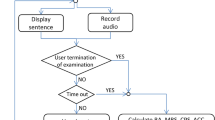Abstract
Purpose
To assess the performance of normal eyes in reading low-contrast texts.
Methods
We selected 14 subjects aged 20 to 31 years (mean, 23 ± 3 years) with corrected visual acuity of 1.0 or better. The subjects were asked to read texts when the contrast between the characters and background was adjusted to 100%, 40%, 20%, and 10%. Using a computer-generated reading chart, reading acuity (RA), critical character size (CCS), and maximum reading speed (MRS) were assessed. The reading performance was compared at various contrast levels.
Results
When the contrast between the characters and background was 100%, 40%, 20%, and 10%, the mean RA (logMAR) was −0.08 ± 0.07, 0.03 ± 0.09, 0.13 ± 0.09, and 0.26 ± 0.11, respectively; the mean CCS (logMAR) was respectively 0.10 ± 0.09, 0.18 ± 0.09, 0.29 ± 0.14, and 0.41 ± 0.10. The mean MRS (characters/min) was 379.2 ± 41.9, 369.7 ± 43.3, 369.2 ± 60.2, and 343.7 ± 67.0, respectively. In all subjects, a decrease in contrast was associated with an increase in RA and CCS, but the MRS was not affected.
Conclusions
In normal eyes, even when reading low-contrast texts, increasing the character size makes it possible to maintain the same MRS as when reading high-contrast texts.
Similar content being viewed by others
References
Verdon W, Bullimore M, Maloney RK. Visual performance after photorefractive keratectomy. A prospective study. Arch Ophthalmol 1996;114:1465–1472.
Leat SJ, Woo GC. The validity of current clinical tests of contrast sensitivity and their ability to predict reading speed in low vision. Eye 1997;11:893–899.
Legge GE, Rubin GS, Luebker A. Psychophysics of reading—V. The role of contrast in normal vision. Vision Res 1987;27:1165–1177.
Rubin GS, Legge GE. Psychophysics of reading. VI—The role of contrast in low vision. Vision Res 1989;29:79–91.
Oda K, Mansfield JS, Legge GE. MNREAD-J: new reading acuity charts for prescribing low vision aids. Proceedings of the 7th Annual Meeting of the Japanese Association of Rehabilitation for the visually impaired; 27–28 June 1998; Chiba, Japan. p. 157–160.
Michelson A. Studies in optics. Chicago: University of Chicago Press; 1927.
Legge GE, Pelli DG, Rubin GS, Schleske MM. Psychophysics of reading. I. Normal vision. Vision Res 1985;25:239–252.
Bailey IL, Bullimore MA, Raasch TW, Taylar HR. Clinical grading and the effects of scaling. Invest Ophthalmol Vis Sci 1991;32:422–432.
Author information
Authors and Affiliations
Corresponding author
About this article
Cite this article
Fujita, K., Oda, K., Watanabe, J. et al. How normal eyes perform in reading low-contrast texts. Jpn J Ophthalmol 52, 44–47 (2008). https://doi.org/10.1007/s10384-007-0494-6
Received:
Accepted:
Published:
Issue Date:
DOI: https://doi.org/10.1007/s10384-007-0494-6




